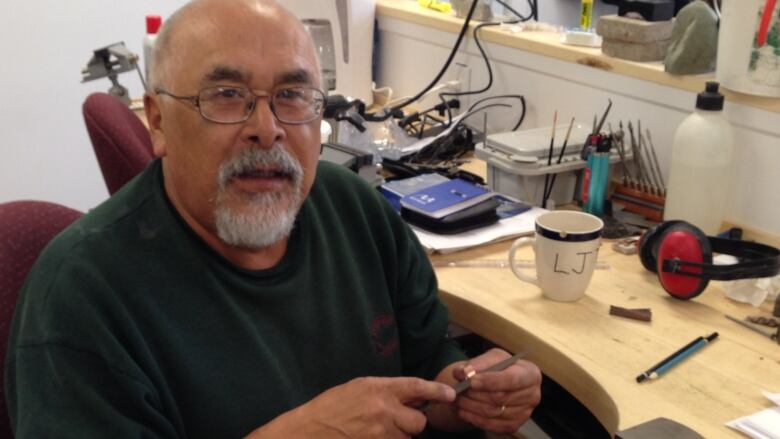Nunatsiavut has highest proportion of artists within province, affirms provincial Vital Signs report

The newly published Vital Signs report for 2016revealsthat Nunatsiavut has the highest proportion of creative and performing artists within the province.
This findingmay come as a surprise when the Inuit region is compared to a hub like St. John's, which attracts creative-types from across the province.
But what the report an annual check-up on the province's quality of life found isn't surprising to Labrador Inuit artist, curator and art historian, Heather Igloliorte, who organised the SakKijjuk: Art and Craft from Nunatsiavut exhibition currently on display at The Rooms in St. John's.
"Oh my god, we have everything there,"Igloliorte said
There are people who knit and sew and do every kind of textile art that you can imagine.-HeatherIgloliorte
Igloliorte said the Vital Signs report brings attention to a pool of artists in Labrador who are doing exciting work in areas like sculpture, jewelry-making and photography,but who aren't receiving the recognition they deserve.
"I think what this report says is there is a lot of artists in Nunatsiavut and they need support and we should treat them like an industry, like any other industry we could be supporting, " Igloliorte said.
Buying arts supplies, finding venues to exhibit work and shipping artwork out of the region are just some of the challenges artists face in Nunatsiavut.
On the flip side, Igloliorte saidthe Vital Signs report does tell artists in Nunatsiavut their work is valued and they are contributing to their communities.

She saidartistic expression is a part of Inuit culture with skills being passed down from generation-to-generation in Nunatsiavut.
Living in remote communities and having limited resources also inspire people to be innovative and creative, she said. Community workshops help to teach skills, as well.
"It's really exciting because it means that the skills and knowledge that we have held in our communities for hundreds of years are now being shared through community programming," she said.
A variety of work
Inuit artistJohn Terriak, who has been carving for more than fifty years in Labrador, saidhe is impressed by the variety of work in the SakKijjuk: Art and Craft from Nunatsiavut exhibition.
Two of his sculptures,Faces in the Hills and Sea Light,are part of the show, which features some 80 works of art and craft from 45 Nunatsiavut artists at The Rooms.
"I always saw Inuit art mostly as carvings and making skin boots, but now it's branched out into more areas," he said, adding that he'simpressed by the print-making, photography, modern Inuit sculptures and fabric art he sees.
"The more art there is, the better. But we still have to keep our traditional style of working."
Growing scene
Terriak said the arts are getting stronger in Nunatsiavut, but he worries the traditional way of working with seal skins to make traditional boots, for instance is disappearing, and he feels it needs to be brought back.
Both Igloliorte and Terriak are optimistic about the future of art in Nunatsiavut, despite the challenges artists face in the region.
Igloliorte saidthe Nunatisavut Government recently appointed a director of culture and a new arts officer to help support artists in Nunatsiavut, which she believes is a positive move.
She also said she wants the public to get excited about Nunatsiavut art to starting buying it, and having it in their homes.
Meanwhile, Terriak credits the Nunatsiavut Government for creating a new jewelry studio in Nain, complete with tools.
He is now participating in a 22-week jewelry-making program to learn new techniques from instructors. Terriak used to work at home alone in his kitchen before the jewelry studio started.
After working for more than 50 years as an artist, Terriak believes the future for art in Nunatsiavut is looking bright.
"I think it's looking up as long as people [artists] keep at it and not give up," Terriak said.
"If the people do a good job and have faith in their work, there will be buyers."












_(720p).jpg)


 OFFICIAL HD MUSIC VIDEO.jpg)
.jpg)



























































































